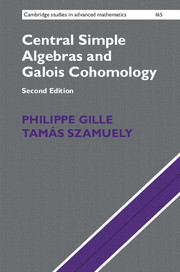Book contents
- Frontmatter
- Contents
- Preface
- 1 Quaternion algebras
- 2 Central simple algebras and Galois descent
- 3 Techniques from group cohomology
- 4 The cohomological Brauer group
- 5 Severi–Brauer varieties
- 6 Residue maps
- 7 Milnor K-theory
- 8 The Merkurjev–Suslin theorem
- 9 Symbols in positive characteristic
- Appendix: a breviary of algebraic geometry
- Bibliography
- Index
4 - The cohomological Brauer group
Published online by Cambridge University Press: 07 August 2017
- Frontmatter
- Contents
- Preface
- 1 Quaternion algebras
- 2 Central simple algebras and Galois descent
- 3 Techniques from group cohomology
- 4 The cohomological Brauer group
- 5 Severi–Brauer varieties
- 6 Residue maps
- 7 Milnor K-theory
- 8 The Merkurjev–Suslin theorem
- 9 Symbols in positive characteristic
- Appendix: a breviary of algebraic geometry
- Bibliography
- Index
Summary
We now apply the cohomology theory of the previous chapter to the study of the Brauer group. However, we shall have to use a slightly modified construction which takes into account the fact that the absolute Galois group of a field is determined by its finite quotients. This is the cohomology theory of profinite groups, which we develop first. As a fruit of our labours, we identify the Brauer group of a field with a second, this time commutative, cohomology group of the absolute Galois group. As applications, we obtain easy proofs of some basic facts concerning the Brauer group, and give an important characterization of the index of a central simple algebra. Last but not least, one of the main objects of study in this book makes its appearance: the Galois symbol.
The cohomology theory of profinite groups was introduced in the late 1950s by John Tate, motivated by sheaf-theoretic considerations of Alexander Grothendieck. His original aim was to find the appropriate formalism for developing class field theory. Tate himself never published his work, which thus became accessible to the larger mathematical community through the famous account of Serre [4], which also contains many original contributions. It was Brauer himself who described the Brauer group as a second cohomology group, using his language of factor systems. We owe to Serre the insight that descent theory can be used to give a more conceptual proof. The Galois symbol was defined by Tate in connection with the algebraic theory of power residue symbols, a topic extensively studied in the 1960s by Bass, Milnor, Moore, Serre and others.
Profinite groups and Galois groups
It can be no surprise that the main application of the cohomological techniques of the previous chapter will be in the case when G is the Galois group of a finite Galois extension. However, it will be convenient to consider the case of infinite Galois extensions as well, and first and foremost that of the extension ks|k, where ks is a separable closure of k.
- Type
- Chapter
- Information
- Central Simple Algebras and Galois Cohomology , pp. 105 - 138Publisher: Cambridge University PressPrint publication year: 2017



